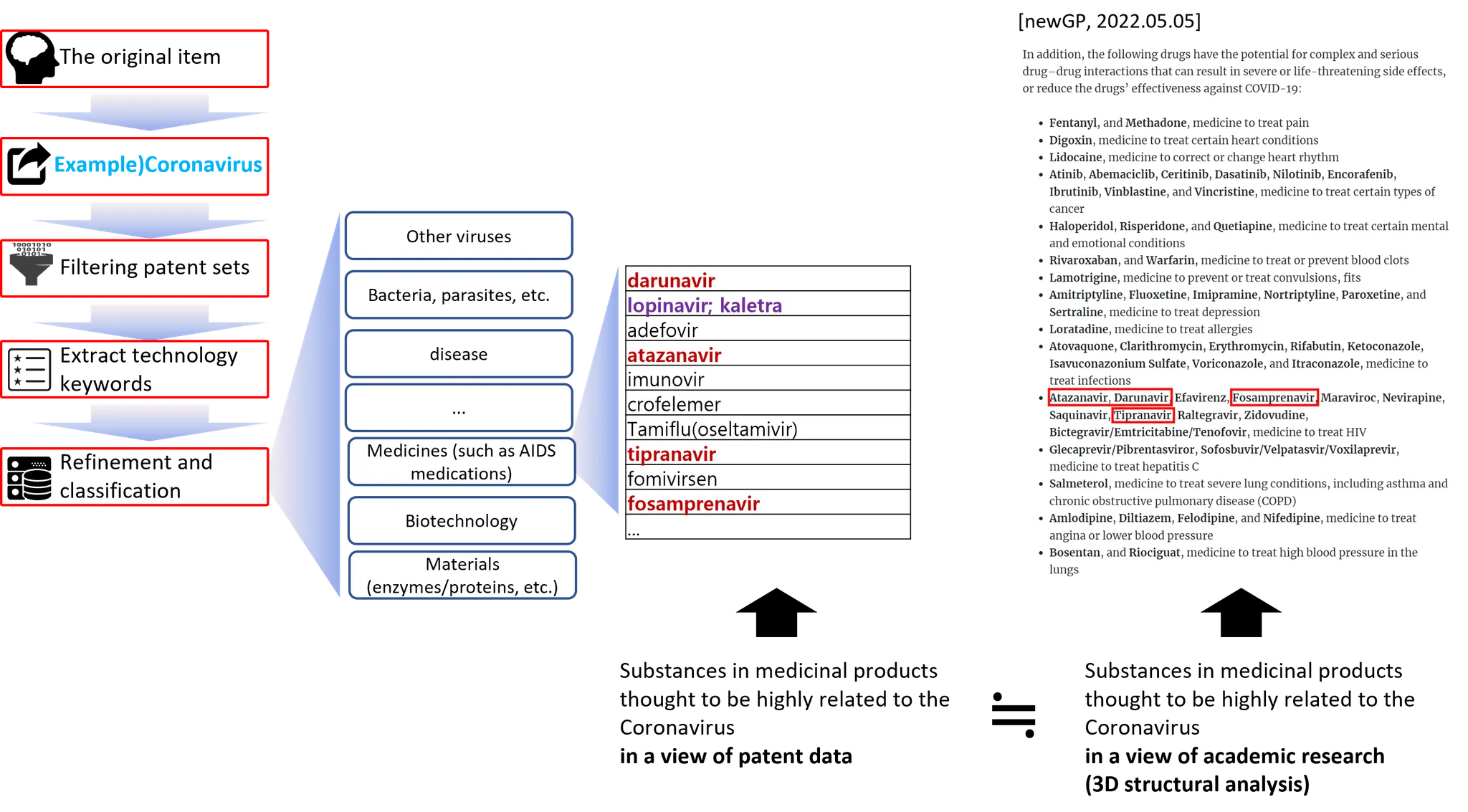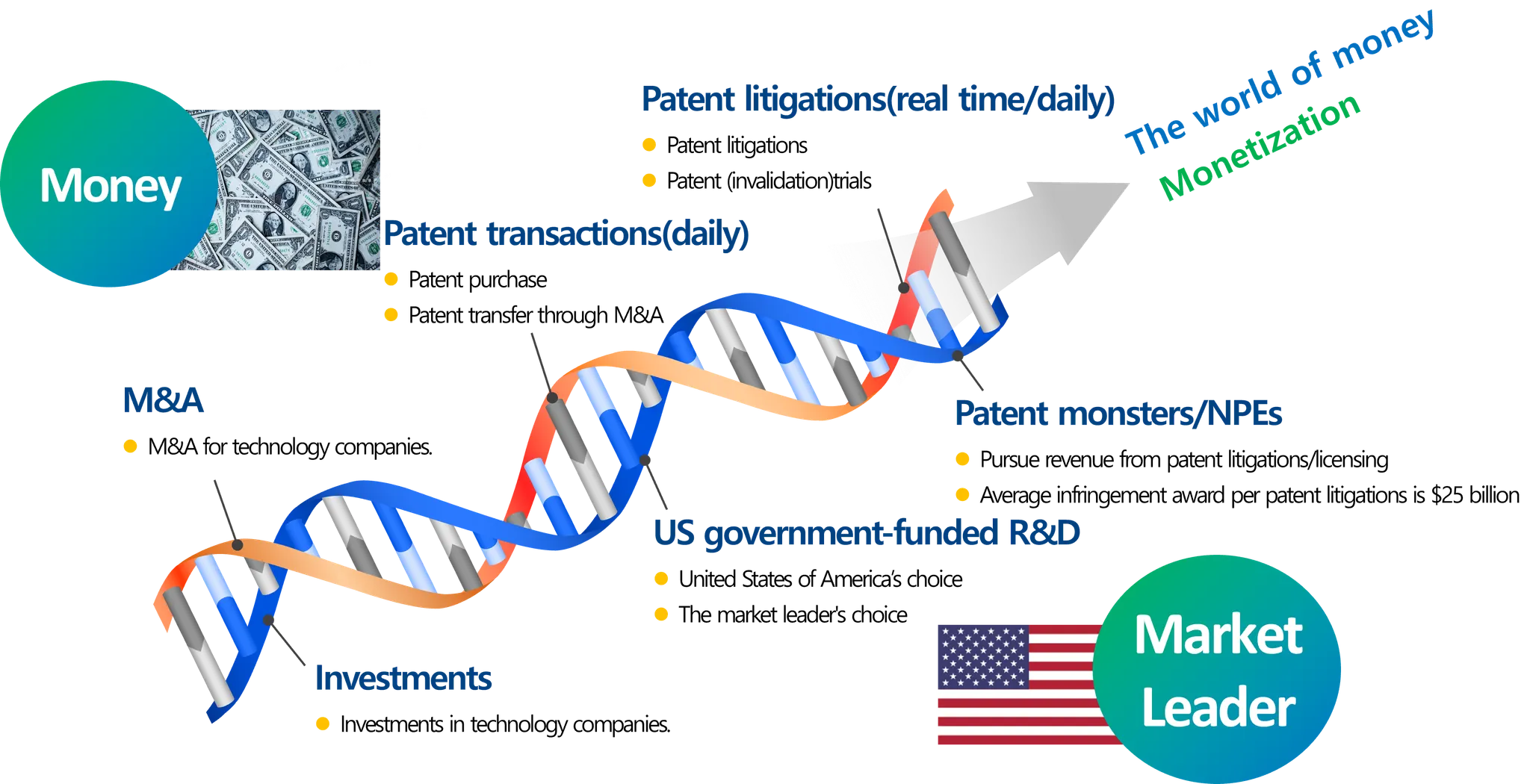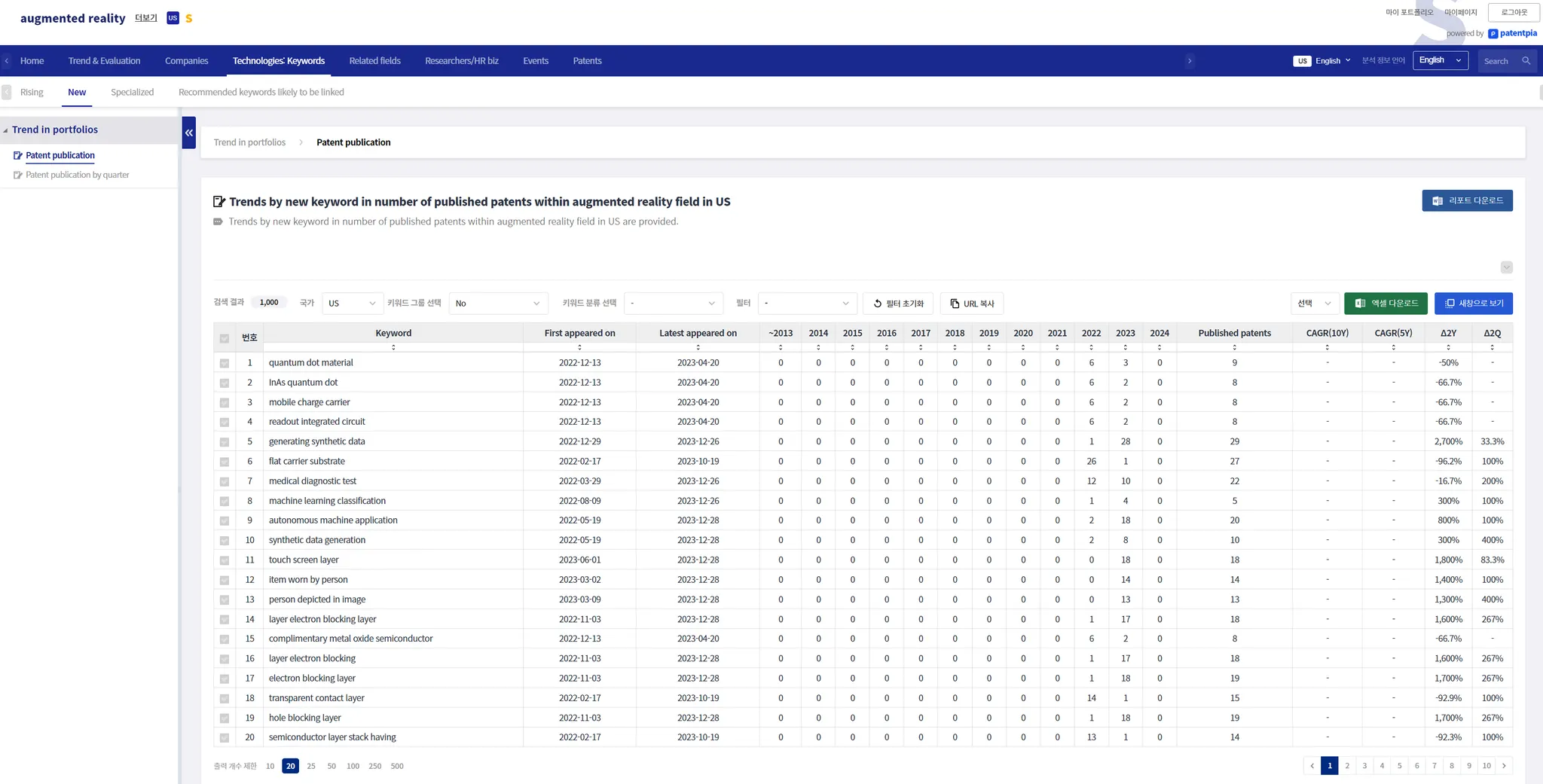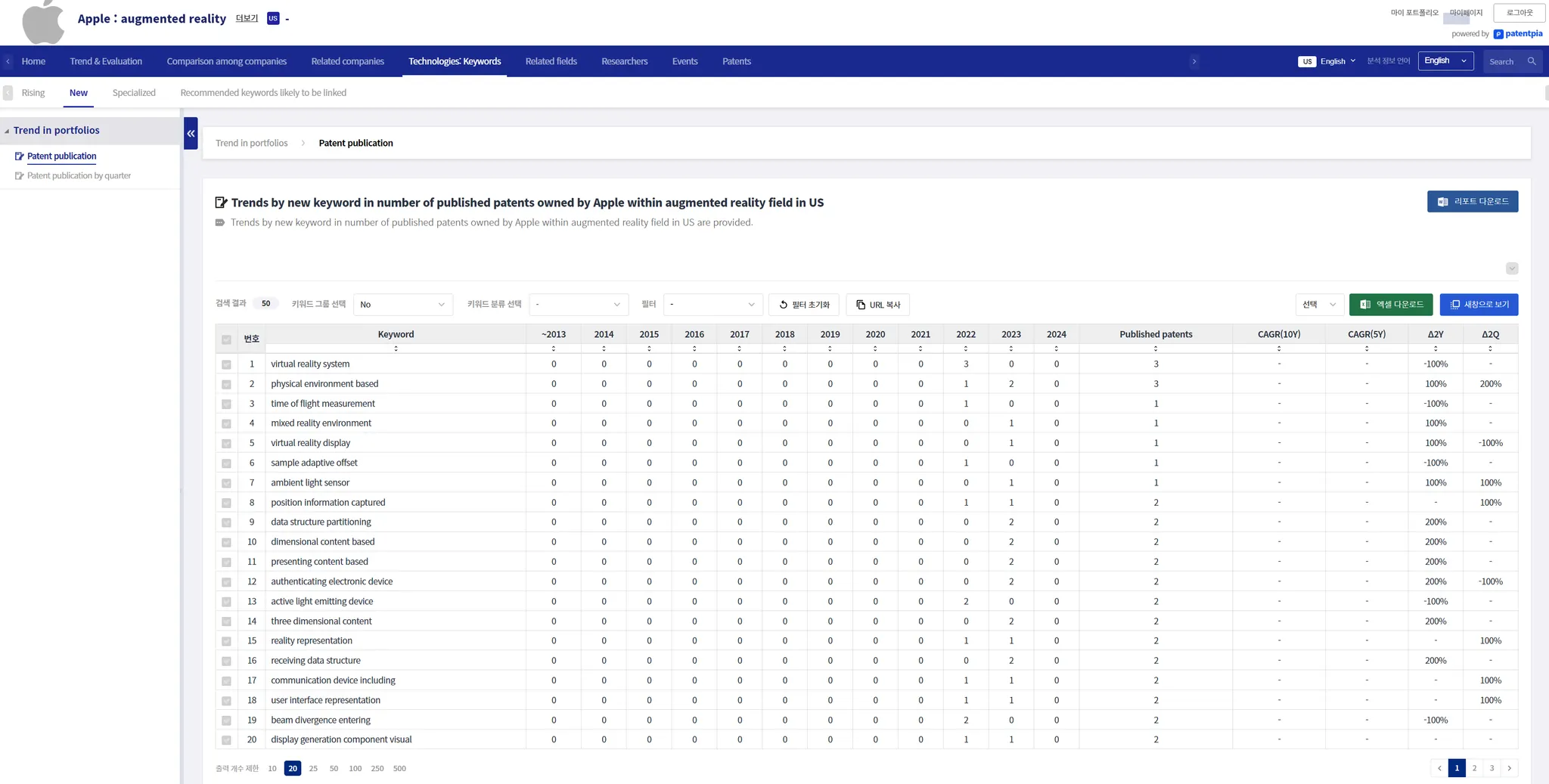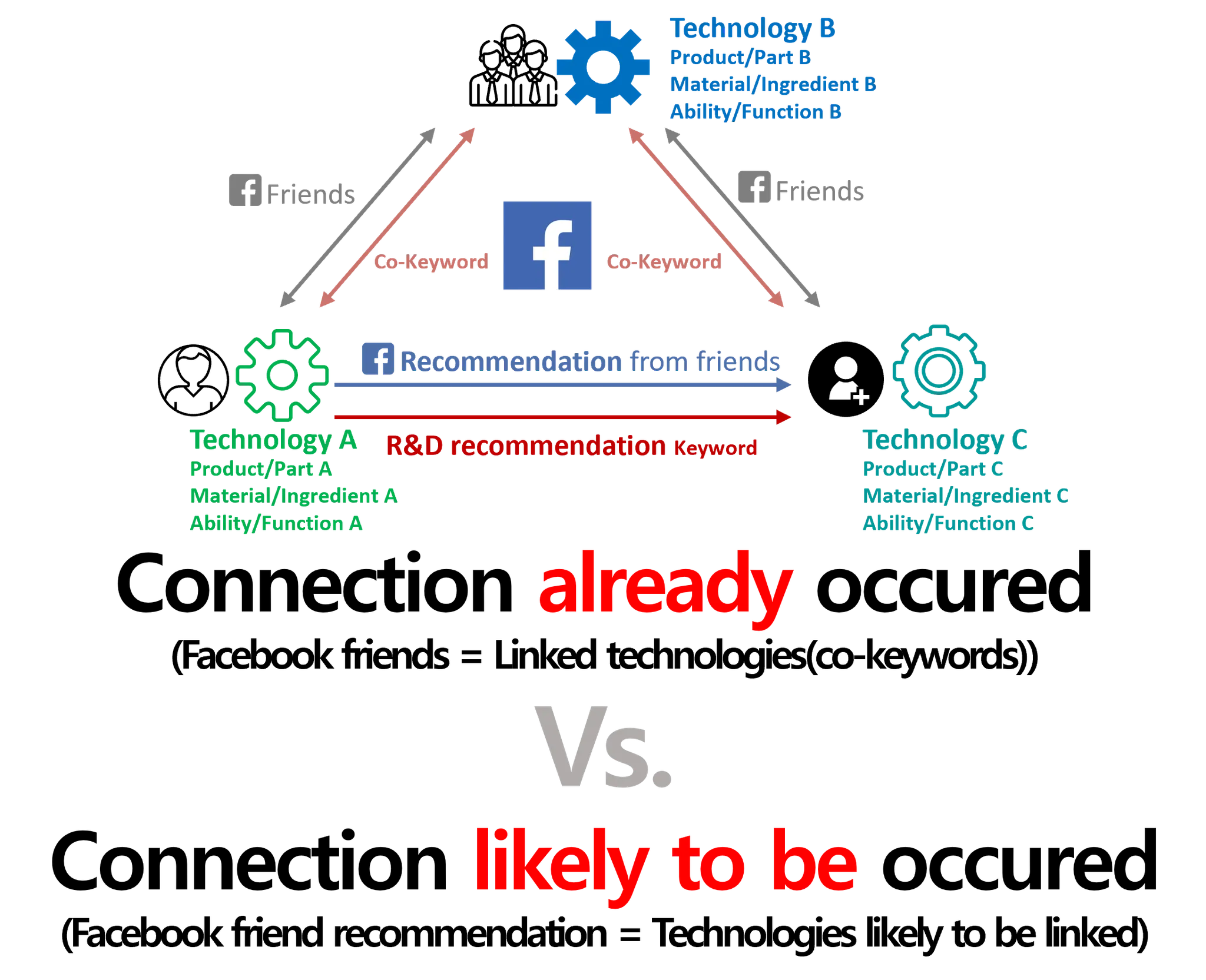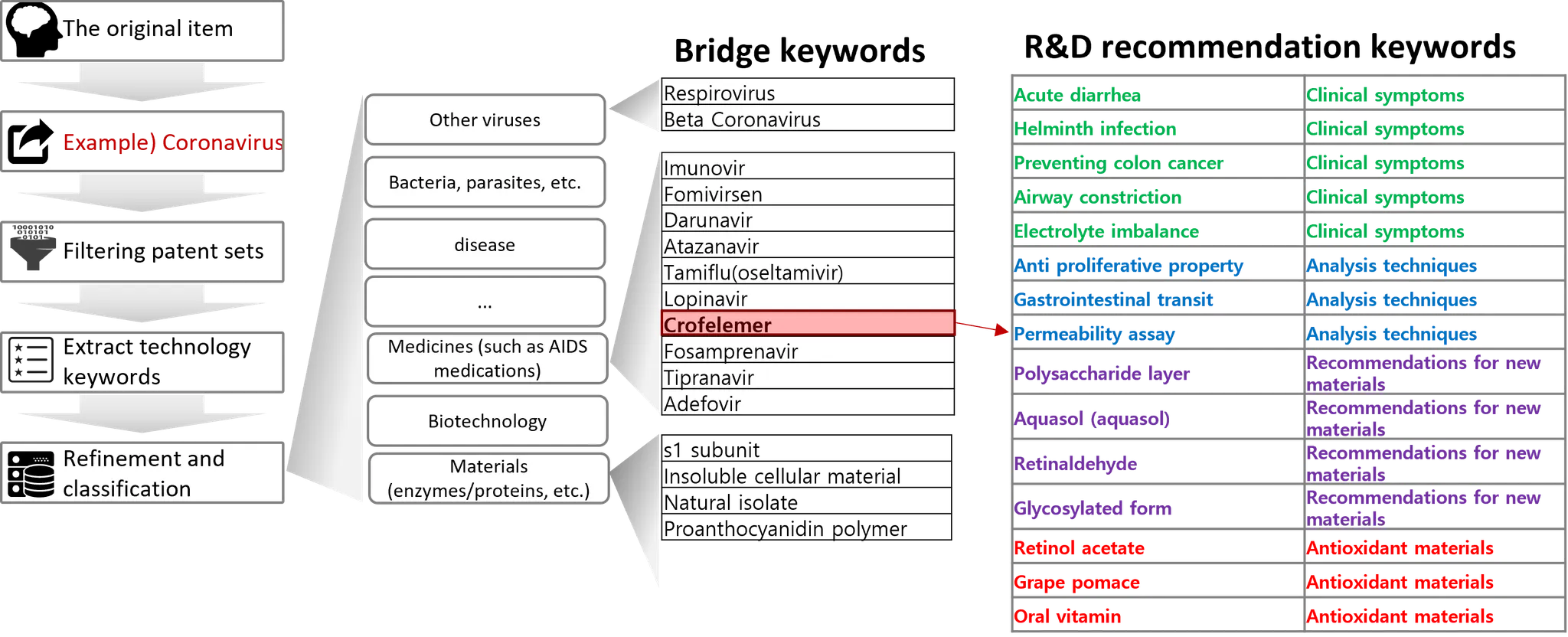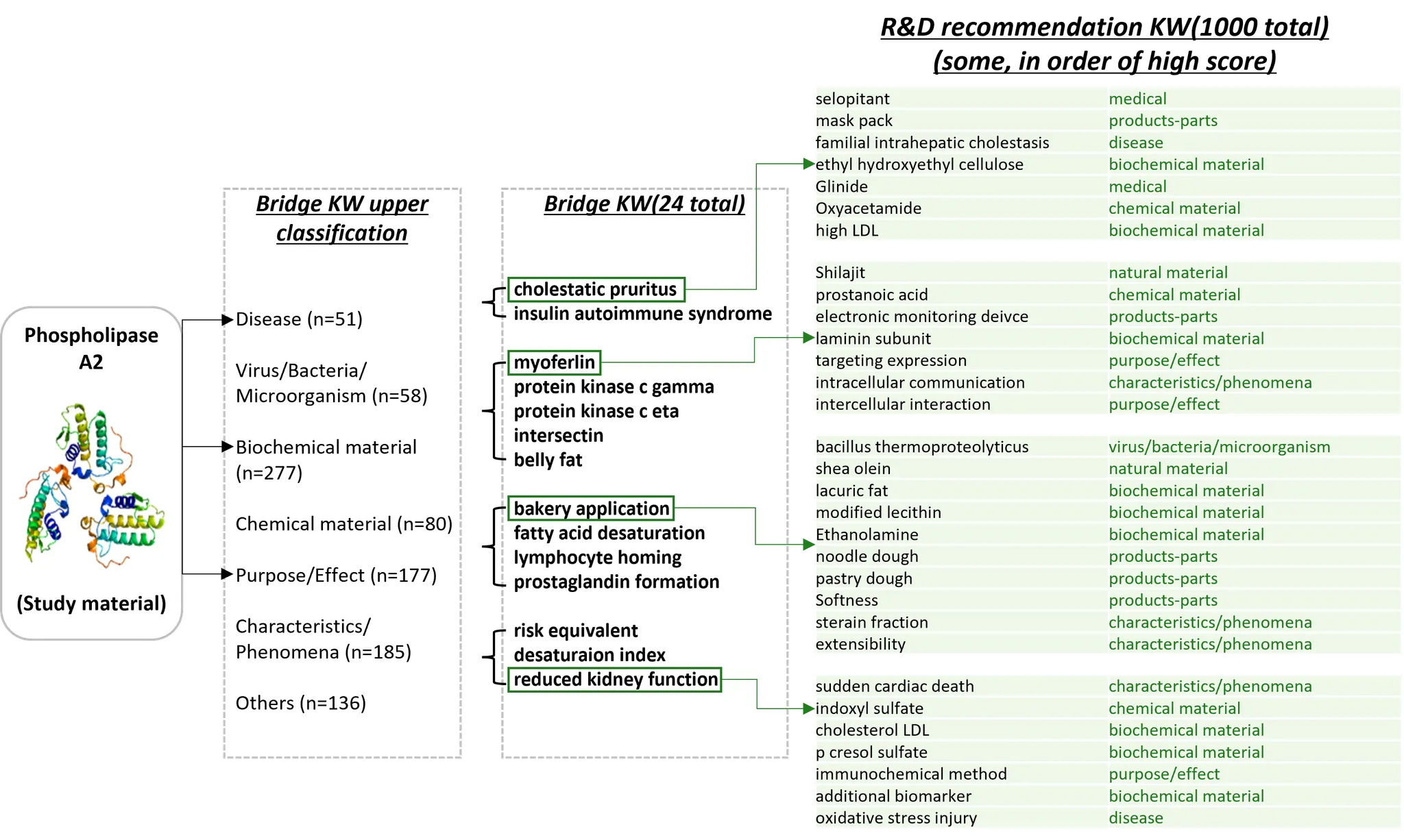New features and new concepts ideation utilization map
Provides new function and new concept ideation contents utilizing PatentPia GoldenCompass, with Apple as the company example, Augmented Reality (AR; AR glass) as the technology field example, and augmented reality as the keyword example. If you click on the chain(link) indication that is attached to each item in the above utilization map, the example page will open in a new window.
New feature and new concept ideation utilization tool scheme description
Keyword extraction
PatentPia GoldenCompass provides keyword analysis data extracted from each nation's patent set that is mapped by input items (company, technology field, keyword, researchers, etc.). The analysis per extracted keyword includes the time of occurrence of the keyword (when the patent was published) and its frequency. Meanwhile, extracted keyword analysis data is also provided for composite items (company's field, company's keywords). About 50 to 100 keywords are extracted per patent.
Keyword segmentation
If there are too many keywords (e.g., market leaders such as Apple have tens of thousands of patents), it will take too much effort to review them. Therefore, you can segment the keywords. The segmented keywords are presented as a 'menu', so you can view the segmented keywords with just a click.
The segmentation axes include i) time, ii) space, and ii) inclusion in special patents.
In the time view, there are i) rising keywords, ii) new appearing keywords. Fast-growing keywords are keywords that have a high rising growth rate in recent quarters/2 years/4 years/6 years/10 years in patents related to the input item (e.g., Apple, etc.) are prioritized. New appearing keywords are prioritized to those keywords that only appear for the first time in the recent 2 years (8 quarters) in patents related to the input item (e.g., Apple's augmented reality, etc.).
The spatial view includes i) specialized keywords, which are keywords that are highly prevalent in patents related to input items (e.g., Apple or Apple's augmented reality), but relatively infrequent in non-input items, i.e., keywords that are specialized only in patents related to input items.
The special patents include i) patents transferred through M&A, ii) patents related to litigated patents, such as litigation/judgments, iii) patents related to standards/government-funded R&Ds/FDA approvals, etc., and iv) rapidly growing patents, such as invention spikes, etc.
Keyword classification
The keyword classifications provided by PatentPia GoldenCompass include i) General Comprehensive Classification, ii) Concept Classification (coming very soon), iii) Purpose-Solution-Problem Classification (coming very soon), etc.
The general comprehensive classification categorizes keywords into 20 major classifications, such as products-parts, materials-substances, diseases, functions-actions, etc., and 300 minor classifications, such as electronic products, polymer materials, etc., by keyword.
Concept classification is organized by keyword into 10 major categories such as relationship, auto-autonomy, prediction, eco-friendly, etc. and 200 subcategories.
Purpose, solution, and problem classifications are assigned 100 subcategories under 10 major categories such as improvement, enhancement, blocking, removal, etc.
Sorting system
PatentPia GoldenCompass provides various sorting (sorting) features in the keyword list, such as i) sorting by descending order of first appearing day, ii) sorting for total/yearly/quarterly values, sorting by 10-year/5-year/2-year/2-quarter increase rate, etc.
Recommended keywords
PatentPia GoldenCompass recommends keywords that have not appeared together in the same patent, but are likely to appear together in the near future, based on the individual patents that comprise the patent set mapped by keyword and input item. Keywords that have appeared together in the same patent are called co-occurring keywords. Keywords that are not co-occurring keywords, but are likely to become co-occurring keywords in the near future are called keywords likely to be linked.
Supporting global patent data utilizing product/service plan(discovering new features/utilization/convergence fields, etc.)
Standing on the shoulders of giants
Planning/ideation of new and innovative features or concepts for new products/new services is a key concern and pain point for many organizations, including technology/product planning organizations, R&D organizations, marketing organizations, etc. For this purpose, buzz, complaint/evaluation data is collected from social sources, and demand from clients or market is constantly researched and analyzed.
Global patent data is the culmination of collective technology intelligence; and, global patent documents are also an encyclopedia of methods of solutions to technical problems (SOLUTION); hence, patent data is the crown jewel of the technology field in comparison with anything else, as it contains the technical achievements of researchers/technologists/engineers from all over the world for more than 100 years.
As Isaac Newton once said, "If you stand on the shoulders of giants, you can see farther than they can," and we need to utilize the giant that is global patent data wisely.
Harnessing global patent big data to unlock innovation
Mining for co-occurring keywords that appear together in patent documents, such as the keyword Coronavirus, has yielded some surprising results, including a number of matches to candidate materials for coronavirus treatment from newspaper articles. This example hints at the possibility of finding clues to innovation in technology's collective intelligence - global patent big data.
On the other hand, patent data not only has the advantages of papers such as citation information/No. of patents related to government-funded R&D, etc., but also contains abundant capitalistic elements that are not present in papers such as transactions/litigations/M&A/investments/standards/FDA approvals, etc. Therefore, if these elements are effectively utilized, differential performance can be achieved in i) technology sensing, ii) technology/R&D planning, iii) new product/new service feature/concept planning, iv) utilization/convergence/application exploration, etc.
Planning support (discovery of new features/utilization/convergence fields, etc.) contents service scheme
Reasons for keyword utilization planning support and 2 utilization tracks
Smartly utilizing classified keywords can help in various planning activities such as i) planning/ideation of new functions/concepts/characteristics, etc. for products/services, and ii) discovery of utilization/application/convergence/application fields. In particular, keywords extracted from global patents of market leading companies or strong companies in each field can be used for convenient/quick execution of the planning/ideation process. In addition, if patent data, which is objective data in the technology field, is well utilized, objective evidence data for planning/ideation can be obtained.
Why keyword contents can be used to support planning.
Think out vs. see & think
It's really hard to think out of nothing, but it's much easier to see & think.
Co-occurring keywords vs. keywords in a company's field
1.
co-occurring keywords (co-keywords)
Co-occurring keywords are keywords that appear together in a specified same scope of the same patent. The specified same scope includes: i) title + abstract + claims of the same patent, ii) claims of the same patent, iii) same paragraph, iv) same sentence, iv) title + abstract of the same patent, v) entire scope of the same patent, etc. GoldenCompass uses the "title+abstract+claims of the same patent co-occurring keywords of scope as a priority, and we are expanding the kinds of scope (coming soon).
2.
co-occurring keywords
GoldenCompass provides co-occurring keyword contents when the own (input/selected) item is a keyword. Co-occurring co-keywords that co-appear in i) keywords, ii) companies' keywords, and iii) patents that correspond/map to researchers' keywords can be i) aggregated time series, ii) calculated growth rate, and iii) calculated when they first co-appear. These correspond to i) co-occurrence time series analysis contents, ii) rising co-occurring co-keywords contents, and iii) new appearing co-keywords contents, respectively, between "Keywords vs. Co-keywords".
As you can see in the example below, some of the recent co-occurring keywords for "augmented reality" are "readout integrated circuit" in line 3, "medical diagnostic test" in line 7, "item worn by person" in line 11, and so on. Looking at the co-occurring keywords for "augmented reality," we can see & think about the following,
•
Product/Part Related :
•
Field of Application :
•
Usage/Utilization environment :
These ideas can be described in the patent, but they don't have to be. In particular, there is a numerical value of the frequency of appearance for each co-occurring keyword, and clicking on the numerical value → outputting the corresponding patent list → clicking on the patent → outputting the patent content. Therefore, it is possible to refer to the thoughts of others (or giants) through drawings (pictures) or detailed descriptions of invention included in the patent content.
Keywords extracted from patents related to field of company or enterprise: stand on the shoulders of giants
You can extract keywords from domestic and foreign patents corresponding to the company itself or the company's field, such as global market leaders, technology leaders, or industry powerhouses. The extracted keywords help you to see and think.
As you can see from the example below, the No. of co-occurring keywords appearing in "Apple's" "augmented reality" patent include various keywords related to i) concept, ii) function, iii) material/substance, iv) part, etc.
New appearing keywords are extracted from the keywords contained in the patent set that are assigned/respond to/mapped to their own (input/selected) items, which are only recently appearing for the first time.
2 tracks of keyword utilization: keywords already connected vs. recommended keywords that are likely to be connected
Recommended keywords with high connection potential contents
There are two series of keyword contents (output) that appear in the analysis results by keyword, company, field, and company's keyword/field items (input) provided by GoldenCompass. One is i) keywords that have appeared (together) in patents, which is where most of the keyword contents(output) fall. The other is keywords with a high probability of being connected. Highly connected keywords are those that i) within the scope of patent documents mapped to the keyword and company's keyword items(input) in a given nation, ii) have never appeared together with the keyword in the same patent document (non-co-occurring keywords), and iii) are network-wise likely to appear together in the near future.
Why use highly connected keywords recommended contents?
Highly connected keywords are keywords that have never appeared together with a given keyword item (INPUT) in the same patent. The reasons for utilizing keywords that have never appeared together in planning support are as follows.
•
Strong heterogeneous convergence/combination/utilization/application (heterojunction that others haven't thought of (and therefore didn't appear together in the patent))
•
Unconventional
•
Reluctant to see & think anyway, used in the planning/ideation stage, not as an actual product/service
Examples of recommended keywords with high connectedness Example of recommended contents
You can find clues to innovations that were not in the patent world through R&D recommendation keywords for the keyword Coronavirus. To find clues to innovation, we utilize keywords that have never appeared together in the same patent as the keyword, but are likely to appear together in the near future based on network analysis.
Support for planning/ideation using classification
Mapping potential attribute classification of → output keywords based on attributes of input
For the object you want to plan (the own (input/selected) item), you can distinguish the characteristics of the product/part, material/substance, technology, disease, expected market demand, etc. Similarly, once the classification of your own (input/selected) items is determined, you can also apply 1 or 2 DEPTH classification to the co-occurring keywords (MAX 2,000) OUTPUTS of these items, reducing the number of OUTPUTS. By gathering them under the same classification and reducing the number, you can effectively focus your thoughts (virtual splicing).
Input is eco-friendly material/substance
If the input is a material/substance, the planning goal can be, for example, i) a new product/part as an object to which this material/substance is applied/utilized/used, ii) a special physical or chemical property for this material/substance, iii) a new concept/characteristic/purpose/effect for this material/substance, etc.
Input is a product-part
If the input is a product/part, for example, i) a new product/part as an object to which this part is applied/utilized/used, ii) a special function for this product/part, iii) a new concept/characteristic/purpose/effect for this product/part, etc. can be the planning goal.
Input is a disease
If the input is a disease, for example, i) medicinal materials/gene/enzyme/natural substances that can be applied/utilized/used for this disease, ii) diseases/illnesses/symptoms/markers associated with this disease, iii) new concepts/characteristics/causes/purposes/effects for this disease, etc. can be planning goals.
Input is data technology
If the Input is a data technology, the planning objectives could be, for example, i) new services/systems to which this data technology is applied/utilized/used, ii) other data technologies/algorithms for this data technology, iii) new concepts/characteristics/purposes/effects for this data technology, etc.
Input is demand/concept
If the input is a demand/concept, the planning objectives can be, for example, i) a new product/part as an object to which this demand/concept is applied/utilized/used, ii) a new substance/substance, special physical or chemical property/function for this demand/concept, iii) a new concept/characteristic/purpose/effect for this demand/concept, etc.

